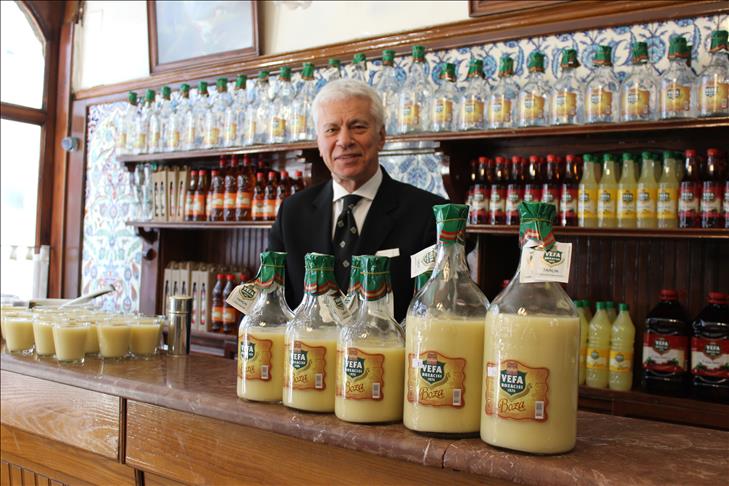9,000-year-old Turkish 'energy drink' still on high demand
'Boza', the traditional Turkish drink made of corn semolina, is still served in its original style at historical small shop since 1867 in Istanbul

ISTANBUL
By Esra Kaymak
"Boza", a traditional Turkish drink, is mostly preferred in winter times for its being a source of warmth, energy and nutrition with vitamins B1, B2, B3, B6 and B12.
Boza which is made of corn semolina by Turks dates back to the 6th century BC.
Used as both a drink and food by Turks since their initial arrival from the Central Asia, Boza has become an indispensable cultural staple over history.
An antiseptic, Boza has plenty of beneficial bacteria and is good for athletes, pregnant women, nursing mothers, stress reduction, relaxation, and patients suffering from cholera and obesity.
Explaining that the ingredients include wheat, cracked wheat, rice or corn depending on different regions, the head of the most renowned Boza brand "Vefa Bozacisi", Sadik Vefa, said they have maintained the tradition in its original style since his grand-grandfather Haci Sadik Bey, whose special Boza was adored by Istanbulites.
"Haci Sadik Bey prepared his newly-fermented special Boza with dark consistency in a small place in the ground floor of his house and carried the Boza-full keg on his shoulders to sell it on the streets of Sultanahmet, Suleymaniye and Beyazit [...] After six years, he decided to open a shop in the historical Vefa district, which was the first corporate shop for Boza. Since then, 'Vefa Bozacisi' still serves Boza lovers without conceding from its quality, raw material nor the way it's prepared," Vefa told AA in an exclusive interview.
He added Boza, the natural energy-drink, was an 'advantage and chance' not for only Turks, but the whole world as it was a product of 'human-requirement'.
- "Japanese and Korean tourists are top Boza demanders"
Vefa noted tourists also visit the historical place to drink Boza and "wonder in great astonishment of how such a taste was still drank in its original form," adding especially the Japanese and Koreans from the Far East adored the drink, who never left the shop without drinking their whole cup of Boza.
"European tourists prefer to 'eat' Boza with a spoon, putting some roasted chickpeas on it," Vefa stressed.
He also added the tourist guides brought their groups to the place even during the summer time to have Boza, noting except day of sorrows, the shop has always been open to Boza lovers.
Upon a question on whether they would open new offices abroad and promote the traditional Turkish-patented drink, Vefa noted mostly the citizens in Germany of Turkish origin have offerred to aquire a franchise for multiple times.
"We will give opportunities to open new franchises in several regions in the coming years. Now, our distributions continue within Turkey in Ankara, Adapazari, Duzce, Yalova and Eskisehir, but our goal is to enlarge. Except these, Turks living in Germany have a great demand to open franchises. We'll also fulfill their demands. We need to lead these demands up in a sort of way," Vefa noted.
He added they would focus on giving franchises to Germany and Austria, where Turks live most and enlarge afterwards to the cold countries with hard winter conditions.
All of these were related to the full usage of the capacity, Vefa said and added they first had to "have a reliable and enough capacity."
Reminding also that Boza was made in the Ottoman Empire during journeys and voyages of the soldiers to give them energy and power, Vefa said they kept the Boza alive, which totally belongs to the culture.
"Our slogan intended to our customers is: You put years on us but never made us old. It is clearly apparent on our 138 years old doorstep," he added.
- How is Boza made?
Although there are many opportunities for basic material to make Boza, Vefa Bozacisi prefers to use corn semolina as it was used 138 years ago. First of all, the very small spica, which grows in East Anatolia and Central Anatolia is milled in the stone mill. Than, the wheat gets separated from the chaff and its semolina is taken to be boilt. After a thick dough comes out of the boilt part, it gets macarated with water and filtered. The required part for daily usage is taken out of the part and gets sweeten with only %20 sugar. The part is finally left for fermentation and served afterwards in different sizes to Boza lovers.
From father to son, 'Vefa Bozacisi' is the first corporate shop in the history, which sells Boza for 138 years in Turkish Istanbul's Vefa district. The name of the shop comes from the region, where Boza is served since 1876 in its original workplace and style.
englishnews@aa.com.tr
Anadolu Agency website contains only a portion of the news stories offered to subscribers in the AA News Broadcasting System (HAS), and in summarized form. Please contact us for subscription options.

